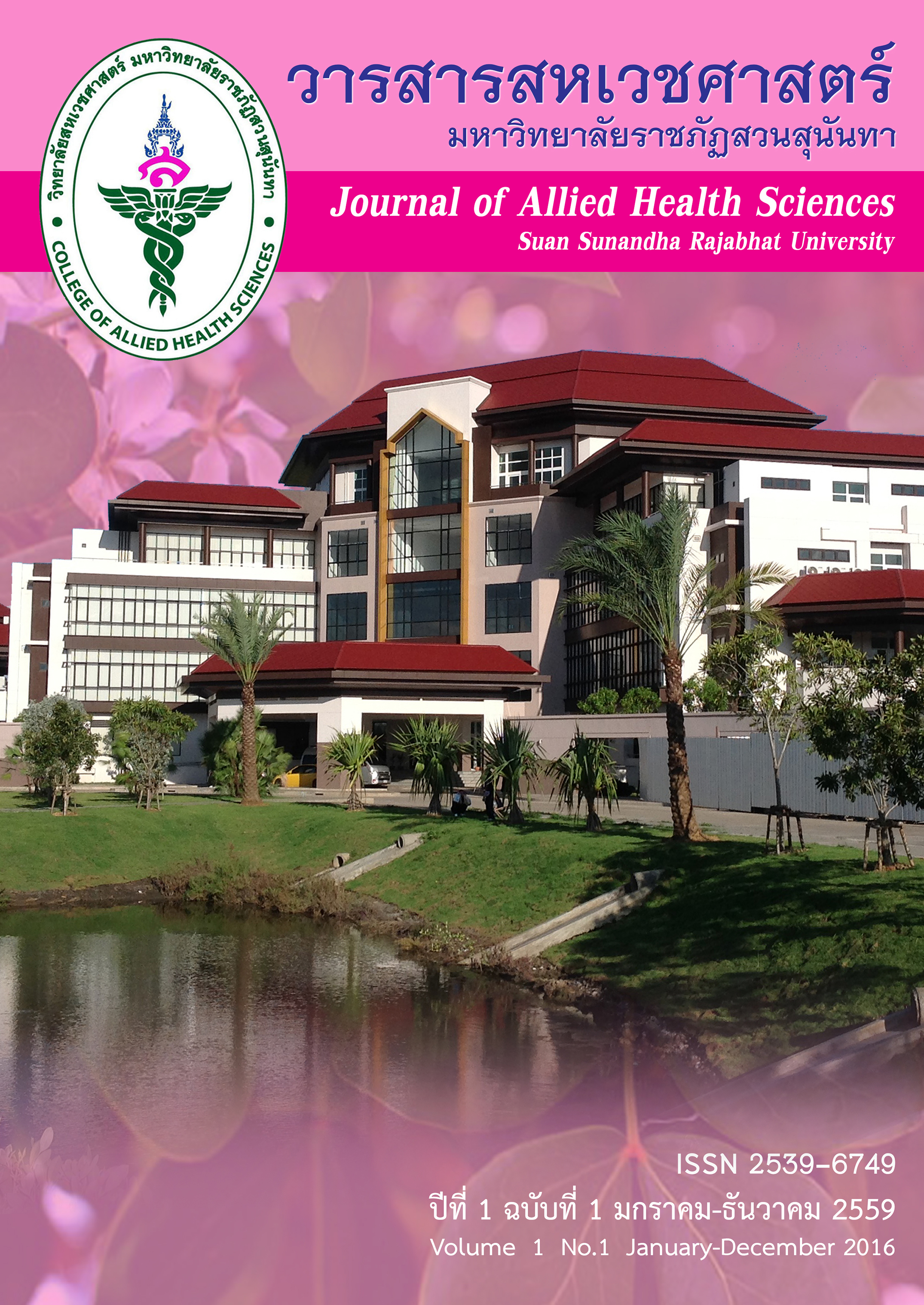การศึกษาเชิงวิเคราะห์เกี่ยวกับผลกระทบที่เกิดจากอาการปวดกล้ามเนื้อและเนื้อเยื่อพังผืด An Analytical Study of the Impact Caused by the Myofascial Pain Syndrome: MPS.
Main Article Content
บทคัดย่อ
ปัจจุบันประชากรกว่า 1.5 พันล้านคนทั่วโลกต้องทนทุกข์ทรมานจากอาการปวดกล้ามเนื้อเรื้อรัง
ที่สำคัญเป็นปัญหาสุขภาพต่อผู้ป่วย และเป็นภาระต่อหน่วยบริการสุขภาพ จากการศึกษาในต่างประเทศ พบว่า
ความชุกของอาการปวดกล้ามเนื้อ ของชาวอเมริกัน พบร้อยละ 48 ประเทศอังกฤษ ประมาณร้อยละ 12.1
ของการมารับการรักษาจากแพทย์เวชปฏิบัติทั่วไป (GP) โดยเฉพาะในอาชีพนักคอมพิวเตอร์พบได้ถึงร้อยละ 86 ประเทศไทยมีอุบัติการณ์ของการเกิดเกี่ยวกับกล้ามเนื้อและเนื้อยึดเสริม จากรายงานผู้ป่วยนอกพบสถิติการเจ็บป่วยเท่ากับ เท่ากับ 309.06 ต่อพันคน สูงเป็นลำดับที่ 3 ของสาเหตุการเจ็บป่วยรองจากโรคระบบทางเดินหายใจ
และระบบไหลเวียนโลหิต ตำแหน่งที่มีอาการปวดมากที่สุด คือ หลัง คอ บ่า และไหล่ และพบมากในกลุ่มอายุระหว่าง 20 – 60 ปี ซึ่งเป็นวัยทำงานซึ่งเป็นกำลังสำคัญหลักในการพัฒนาประเทศต่อไป การศึกษางานวิจัยเชิงวิเคราะห์ครั้งนี้มีวัตถุประสงค์เพื่อสรุปองค์ความรู้เกี่ยวกับผลกระทบที่เกิดจากกลุ่มอาการปวดกล้ามเนื้อและเนื้อเยื่อพังผืด (Myofascial Pain Syndrome: MPS) โดยทำการสืบค้นงานวิจัยที่ได้รับการตีพิมพ์ในวารสารต่างประเทศจากฐานข้อมูลของ Pub Med, Scopus และ BMJ Best Practice และงานวิจัยในประเทศไทย จากฐานข้อมูล Journal Link ประเทศไทยซึ่งได้รับการตีพิมพ์เผยแพร่ย้อนหลัง ตั้งแต่ ปี ค.ศ. 2005-2015 คัดเลือกงานวิจัยที่เกี่ยวข้องกับผลกระทบที่เกิดจากอาการปวดกล้ามเนื้อ จำนวน 42 เรื่อง งานวิจัยต่างประเทศ 40 เรื่อง และงานวิจัยในประเทศไทย 2 เรื่อง เป็นงานวิจัยเกี่ยวกับผลกระทบต่อสุขภาพ จำนวน 20 เรื่อง ผลกระทบต่อสุขภาพเกี่ยวค่าใช้จ่าย จำนวน 17 เรื่อง และผลกระทบต่อการปฏิบัติงานจำนวน 5 เรื่อง ส่วนใหญ่เป็นงานวิจัยประเภท cross-sectional surveys รองลงมาคือ งานวิจัยประเภท cohort studies และ systematic review
ผลจากการศึกษา พบว่า ผู้ป่วยด้วยอาการปวดกล้ามเนื้อและเนื้อเยื่อพังผืดนอกจากจะได้รับความทุกข์ทรมานจากอาการปวดเป็นสำคัญแล้ว ยังมีผลกระทบต่อการดำเนินชีวิตประจำวัน เช่น มีผลกระทบต่อ
การออกกำลังกาย การยกของ ไม่สามารถออกกำลังกาย และไม่สามารถทำงานนอกบ้านได้ นอกจากนั้น ยังมีผลกระทบต่อสุขภาพ และเศรษฐกิจอีกด้วย เช่น อาการปวดรบกวนการนอนหลับของผู้ป่วย ผู้ป่วยมีความเครียด ความวิตกกังวล และเกิดภาวะซึมเศร้า มีผลกระทบด้านเศรษฐกิจต่อค่าใช้จ่ายในการรักษา โดยเฉพาะอย่างยิ่งค่าใช้จ่ายทางอ้อม (Indirect cost) สูงกว่าค่าใช้จ่ายทางตรง (Direct cost) ตลอดจนมี ผลกระทบต่อการปฏิบัติงานอันเนื่องมาจากการเจ็บป่วย ประสิทธิภาพในการทำงานลดลง และเกิดการเปลี่ยนแปลงหน้าที่ในการปฏิบัติงาน ซึ่งส่งผลถึงรายได้ของผู้ป่วยที่ต้องลดลง เป็นต้น
จากผลกระทบที่เกิดขึ้นอันเนื่องมาจากอาการปวดกล้ามเนื้อและเนื้อเยื่อพังผืด (Myofascial Pain Syndrom: MPS) จึงควรที่จะหาแนวทางในการป้องกันการเกิดโรค รวมถึงวิธีการบำบัดรักษา เพื่อลดความสูญเสียจากการเจ็บป่วยดังกล่าว และหากลดความสูญเสียนี้ได้จะเป็นประโยชน์อย่างยิ่งต่อสุขภาพ ระบบเศรษฐกิจและสังคมของประเทศ
Currently, more than 1.5 billion people suffer from chronic muscle pain which is a major health problem of patients as well as a burden on health services organization. According to the study about the prevalence of muscle pain in the United States found 48% of prevalence in American people, and in England found the prevalence of muscle pain in 12.1% of English people which treated by general practitioners (GP) but 86% out of this amount of people significantly are computer scientists. In Thailand, there is an incident of myofascial pain syndrome. According to the report of the outpatient department, the illness statistics is equal to 309.06 per thousand patients which is a third highest illness rate besides respiratory decease and circulatory system decease. The positions which pain is mostly found are neck, back and shoulders in people from the age of 20 – 60 years old. This analytical research was aimed to summarize the impacts of myofascial pain syndrome by reviewing world-wide published researches from the database of Pub Med, Scopus and BMJ Best Practice and Thai research from the database of Journal Link Thailand which had been published since 2005 to 2015.
42 researches, related to myofascial pain, were selected; 2 researches are from Thailand and another 40 researches are from other countries. There are 20 researches about the impacts on health, 17 researches about the expenses in daily life and 5 researches about the impacts on working performance which mostly are cross-sectional research type followed by cohort studies and systematic review.
The result showed that myofascial pain not only causes patients suffered but also affects their daily lives e.g. being unable to do exercise, carry heavy things or go to work. Moreover, it affects patient’s health and economy status e.g. myofascial pain causes patient insomnia, patient stresses and has anxiety and depress, patients have to spend a great amount of money on treating the pain which indirect cost is significantly higher than direct cost and
the pain also lessens patient’s working ability which affected to their income as well.
According to the impacts of myofascial pain syndrome mentioned above, the proper ways to prevent and cure this syndrome are required in order to lessen the tendency of loss from myofascial pain which will have good effects on people’s health, economy status and social.

